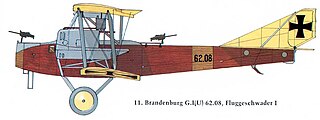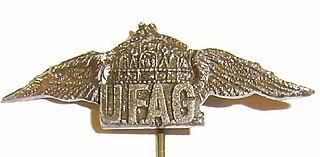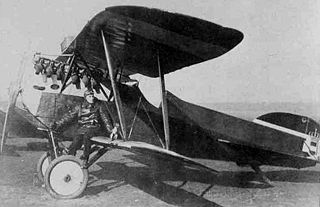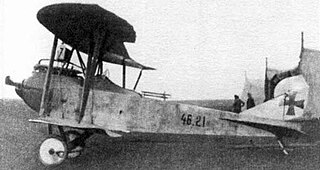
In 1914 Otto Hieronimus manufactured the six-cylinder Hiero E, also known as the Hiero 6 engine which was derived from earlier 4-cylinder engines. The Hiero engine like the Austro-Daimler powered many of Austria's World War I aircraft. Hiero aircraft engines were designed by Otto Hieronimus, a famous Austrian auto racer of the early 1900s. His initial designs were liquid-cooled inline engines built by the Laurin & Klement Automobile Works of Austria.

The Hansa-Brandenburg C.I, also known as Type LDD, was a 2-seater armed single-engine reconnaissance biplane designed by Ernst Heinkel, who worked at that time for the parent company in Germany. The C.I had similarities with the earlier B.I, including inward-sloping interplane bracing struts. Like other early-war Austro-Hungarian reconnaissance aircraft, such as C-types of Lloyd or Lohner, the Type LDD had a communal cockpit for its crew.

The Hansa-Brandenburg CC was a single-seat German fighter flying boat of World War I. It was used by both the Kaiserliche Marine and the Austro-Hungarian Navy.

The Hansa-Brandenburg D.I, also known as the KD was a German fighter aircraft of World War I. Despite poor handling characteristics it was put into service by Austria-Hungary, where some aircraft served until the end of the war.

The Hansa-Brandenburg G.I was a bomber aircraft used to equip the Austro-Hungarian aviation corps in World War I. It was a mostly conventional large, three-bay biplane with staggered wings of slightly unequal span. The pilot and bombardier sat in a large open cockpit at the nose of the aircraft, with a second open cockpit for a gunner in a dorsal position behind the wings. An unusual feature was the placement of the twin tractor engines. While the normal practice of the day was to mount these to the wings, either directly or on struts, the G.I had the engines mounted to the sides of the fuselage on lattices of steel struts. This arrangement added considerable weight to the aircraft and transmitted a lot of vibration to the airframe.
The Aviatik (Berg) D.II, the prototypes of which were known as Aviatik 30.22 and Aviatik 30.38, was an Austro-Hungarian sesquiplane fighter aircraft prototype towards the end of the First World War.

UFAG, was a Hungarian aircraft manufacturer formed by the Ganz Works and the Manfred Weiss Works in Budapest in 1912. They built aircraft of their own design as well as under licence from Lohner and Hansa-Brandenburg.

The Phönix D.I, with the D.II and D.III variants, was an Austro-Hungarian First World War biplane fighter built by the Phönix Flugzeug-Werke and based on the Hansa-Brandenburg D.I.

The Lloyd C.II and its derivatives, the C.III and C.IV were reconnaissance aircraft produced in Austria-Hungary during the First World War. They were based on the Lloyd company's pre-war C.I design, and like it, were conventional biplanes with swept-back wings.

The Lloyd C.V was a reconnaissance aircraft produced in Austria-Hungary during the First World War. It was a departure from Lloyd's previous reconnaissance types, which had all been based on a pre-war design. The C.V was a more compact and streamlined aircraft with an unusual wing structure.

The Lohner B.I was a military reconnaissance aircraft produced in Austria-Hungary during World War I. As Lohner strove to perfect the design, a variety of increasingly powerful engines were fitted, reflected in a range of military designations from B.II through to B.VI until the definitive B.VII was finally produced. This last version was also produced in an armed variant, designated the C.I.

The Lohner B.II was a military reconnaissance aircraft produced in Austria-Hungary during World War I. It was a development of the pre-war B.I design, incorporating changes requested by the Austro-Hungarian army, but inheriting its predecessor's basic design, including its characteristic swept-back wings.

The unarmed Lohner B.VII and its armed derivative the C.I were military reconnaissance aircraft produced in Austria-Hungary during World War I. They were the ultimate developments in a family of aircraft that had begun with the B.I prior to the outbreak of war, and were the first members of that family that proved suitable for front-line service during the conflict. Like their predecessors, the B.VII and C.I were conventional biplanes with characteristic swept-back wings.

The Phönix C.I, given serial numbers in the Phönix 121 range, was an Austro-Hungarian First World War reconnaissance and general-purpose Biplane built by Phönix and Lloyd.
The Ufag 60.03, prototype for proposed production as the Ufag C.II, was a reconnaissance aircraft of the Austro-Hungarian air forces (Luftstreitskrafte), in the First World War. The C.II fared well in the 1918 C-class trials and production was planned but abandoned with the armistice in November 1918. The sole Ufag 60.03 was offered for sale to the Czecho-Slovakian government in 1920.

The Lohner Type AA were a series of prototype fighters built during World War I. The program would eventually be cancelled due to inherent instability concerns of the design.
The Knoller D.I series 70 was a prototype fighter aircraft built in the Austro-Hungarian Empire during World War I for use by the Kaiserliche und Königliche Luftfahrtruppen (KuKLFT).
The Hansa-Brandenburg C.II, company designation K,, was a two-seat reconnaissance aircraft built in Germany by Hansa-Brandenburg in World War I, powered by Mercedes D.III or Hiero 6 water-cooled in-line piston engines.
The Phönix 20.24 was a prototype German fighter plane built in the last months of World War I.
The WFK D.I was a fighter aircraft built in Austria-Hungary in the final months of World War I.















